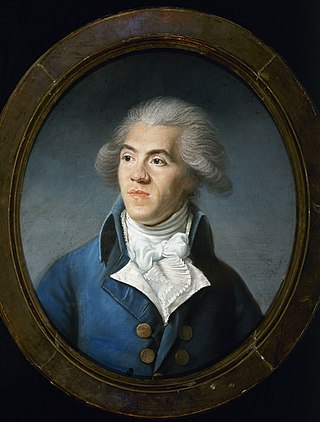
Louis XVI was the last king of France before the fall of the monarchy during the French Revolution.

Honoré Gabriel Riqueti, Count of Mirabeau was a French writer, orator, statesman and a prominent figure of the early stages of the French Revolution.

Antoine Pierre Joseph Marie Barnave was a French politician, and, together with Honoré Mirabeau, one of the most influential orators of the early part of the French Revolution. He is most notable for correspondence with Marie Antoinette in an attempt to set up a constitutional monarchy and for being one of the founding members of the Feuillants.

The royal Flight to Varennes during the night of 20–21 June 1791 was a significant event in the French Revolution in which King Louis XVI of France, Queen Marie Antoinette, and their immediate family unsuccessfully attempted to escape from Paris to Montmédy, where the King wished to initiate a counter-revolution by joining up with royalist troops. They escaped as far as the small town of Varennes-en-Argonne, where they were arrested after being recognized at their previous stop in Sainte-Menehould.

Jean-Marie Roland de la Platière was a French inspector of manufactures in Lyon and became a leader of the Girondist faction in the French Revolution, largely influenced in this direction by his wife, Marie-Jeanne "Manon" Roland de la Platière. He served as a minister of the interior in King Louis XVI's government in 1792.

Armand Marc, Count of Montmorin de Saint Herem was a French statesman. He was Minister of Foreign Affairs and the Navy under Louis XVI.

Jean-Baptiste Robert Lindet was a French politician of the Revolutionary period. His brother, Robert Thomas Lindet, became a constitutional bishop and member of the National Convention. Although his role may not have been spectacular, Jean-Baptiste Lindet came to be the embodiment of the growing middle class that came to dominate French politics during the Revolution.

Jean-Sifrein Maury was a French cardinal, archbishop of Paris, and former bishop of Montefiascone.

Louis Gustave le Doulcet, comte de Pontécoulant was a French politician. He was the father of Louis Adolphe le Doulcet and Philippe Gustave le Doulcet.

Trophime-Gérard, marquis de Lally-Tollendal was a French politician and philanthropist.
Comte Antoine-François Bertrand de Molleville was a French politician.

The Army of Condé was a French field army during the French Revolutionary Wars. One of several émigré field armies, it was the only one to survive the War of the First Coalition; others had been formed by the Comte d'Artois and Mirabeau-Tonneau. The émigré armies were formed by aristocrats and nobles who had fled from the violence in France after the August Decrees. The army was commanded by Louis Joseph de Bourbon, Prince de Condé, the cousin of Louis XVI of France. Among its members were Condé's grandson, the Duc d'Enghien and the two sons of Louis XVI's younger brother, the Comte d'Artois, and so the army was sometimes also called the Princes' Army.

The Musée des Archives Nationales, formerly known as the Musée de l'Histoire de France, is a state museum of French history operated by the Archives Nationales. The museum features exhibitions drawn from the collections of the government archives and aims to provide document-based perspective on France’s history and the evolution of French society. It is housed in the Hôtel de Soubise in the Marais neighborhood in the 3rd arrondissement of Paris, France. It was first established under Napoleon III in 1867, with the direction of Léon de Laborde.

The Constitutional Guard was a French royal guard formation which lasted a few months in 1792 as part of the Maison du Roi, being superseded by the National Guard. It existed in the period of the constitutional monarchy during the French Revolution.
Paul Girault de Coursac and Pierrette Girault de Coursac were two French historians who specialised in the lives of Louis XVI and Marie-Antoinette.
Augustin Blondel de Gagny was a French connoisseur of the arts and a collector whose series of Paris auction sales, which took place soon after his death were high-water marks of the history of collecting in 18th-century France. Paintings and sculptures that passed through Blondel de Gagny's collection are dispersed in many of the world's great museums. The prints from his collection are less easily traced.
Maximilien Radix de Sainte-Foix, born Charles-Pierre-Maximilien Radix de Sainte-Foix, was a noted French financier and politician. He held the position of Superintendent of Finance for the Comte d'Artois. Later, he headed the secret council of advisers for Louis XVI, while the latter was being detained at the Tuileries Palace. He played a big role in the counter-revolutionary circles of the time.
Jean-Claude-Hippolyte Méhée de La Touche (1762-1826) was the son of a surgeon in Meaux. Destined to succeed his father, he nevertheless left his home for Paris when he was 12, and ended up in the Bicêtre Prison. He was released at the Coronation of Louis XVI in 1775, but in 1776, after the death of his parents, Méhée was again imprisoned in the Bicêtre. He escaped when he was sent to Brest to serve on the French fleet. He returned to Paris and was sent to Saint Petersburg as a spy under the name Chevalier de La Touche by Honoré Gabriel Riqueti, comte de Mirabeau and Gilbert du Motier, marquis de Lafayette. He was soon uncovered and was sent out of Russia in March 1791. His next appointment as a spy was in Poland, where he established the Gazette de Varsovie, a French newspaper in Warsaw. Again his role as a spy was discovered, and he was banished from Poland as well.

Pierre Joseph Duhem was a French physician and politician.














